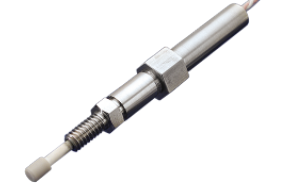Valin provides a tremendous selection of general application, mineral insulated metal sheathed, base metal, high temperature, surface temperature and multipoint thermocouples. Fiberglass insulated thermocouples are capable of temperatures up to 900°F (480°C) for continuous operation. Watlow provides grounded, ungrounded and exposed junctions. Watlow uses a verification process at selected temperature points to ensure products conform to ASTM error limits. Same day shipment on millions of thermocouple configurations is available.
Categories
- Radio Frequency - Accurate temperature readings through radio or conduction environments
- Multipoint - Sensor accurately measures temperature across multiple locations
- High-Temperature - Meets reliability and high performance standards
- True Surface (TST) - Increase thermocouple accuracy with improved thermocouple design
- Microcoil™ - accurate, repeatable, fast response in perpendicular surface measurement
- Mineral Insulated - Fast-responding, durable and capable of handling high temperatures
- Exactsense® - Sensor provides accurate, rapid response exhaust gas temperature measurements for diesel engine after-treatment systems
- General Applications Tube and Wire - Thermocouple designs ideal for medium-duty processes
Calibration Types
Calibration types have been established by the American Society for Testing and Materials (ASTM) according to their temperature versus EMF characteristics in accordance with ITS-90, in standard or special tolerances. Additionally, there are non-ASTM calibration types. These thermocouples are made from tungsten and tungsten-rhenium alloys. Generally used for measuring higher temperatures, they are a more economical alternative to the platinum and platinum alloy based noble metal thermocouples, but limited to use in inert and non-oxidizing atmospheres.
Type B - Maximum recommended operating temperature for Type B is 3100°F (1700°C). Suitable for use in an oxidizing or inert atmosphere. Do not insert in metal tubes. Beware of contamination at high temperatures. Not suitable for use below 122°F (50°C).
Type E - The Type E thermocouple is suitable for use at temperatures up to 1650°F (900°C) in a vacuum, inert, mildly oxidizing or reducing atmosphere. At cryogenic temperatures, the thermocouple is not subject to corrosion. This thermocouple has the highest EMF output per degree of all the commonly used thermocouples.
Type J - Type J is the second most common calibration type and is a good choice for general purpose applications where moisture is not present. The Type J thermocouple may be used, exposed or unexposed, where there is a deficiency of free oxygen. For cleanliness and longer life, a protection tube is recommended. Since iron (JP) wire will oxidize rapidly at temperatures over 1000°F (540°C), it is recommended that larger gauge wires be used to compensate. Maximum recommended operating temperature is 1400°F (760°C).
Type K - Type K thermocouples usually work in most applications as they are nickel based and exhibit good corrosion resistance. It is the most common sensor calibration type providing the widest operating temperature range. Due to its reliability and accuracy the Type K thermocouple is used extensively at temperatures up to 2300°F (1260°C). This type of thermocouple should be protected with a suitable metal or ceramic protection tube, especially in reducing atmospheres. In oxidizing atmospheres, such as electric furnaces, tube protection is not always necessary when other conditions are suitable; however, it is recommended for cleanliness and general mechanical protection. Type K will generally outlast Type J because the JP wire rapidly oxidizes, especially at higher temperatures.
Type N - This nickel-based thermocouple alloy is used primarily at high temperatures up to 2300°F (1260°C). While not a direct replacement for Type K, Type N provides better resistance to oxidation at high temperatures and longer life in applications where sulfur is present. It also outperforms Type K in K’s aging range.
Types S and R - Maximum recommended operating temperature for Type S or R is 2700°F (1480°C). These thermocouples are easily contaminated. Reducing atmospheres are particularly damaging to the calibration. Noble metal thermocouples should always be protected with a gas-tight ceramic tube, a secondary tube of porcelain, and a silicon carbide or metal outer tube as conditions require.
Type T - This thermocouple can be used in either oxidizing or reducing atmospheres, though for longer life, a protecting tube is recommended. Because of its stability at lower temperatures, this is a superior thermocouple for a wide variety of applications in low and cryogenic temperatures. Its recommended operating range is -330° to 660°F (-200° to 350°C), but it can be used up to -452°F (-269°C) (boiling helium).
Junction Types
Generally, the grounded junction offers the best compromise between performance and reliability. It is the best choice for general purpose measurements. Select an ungrounded junction if the lead wire will be shielded and attached to the sheath. Also, select the ungrounded junction to avoid ground loops between instruments, power supplies and the sensor.
Exposed Junction
Thermocouple wires are butt welded, insulated and sealed against liquid or gas penetration. This junction style provides the fastest possible response time but leaves the thermocouple wires unprotected against corrosive or mechanical damage.
Grounded Junction
The sheath and conductors are welded together, forming a completely sealed, integral junction. The grounded junction is recommended in the presence of liquids, moisture, gas or high pressure. The wire is protected from corrosive or erosive conditions. Response time with this style approaches that of the exposed junction.
Ungrounded Junction
The thermocouple junction is fully insulated from the welded sheath end. The ungrounded junction is excellent for applications where stray EMFs would affect the reading and for frequent or rapid temperature cycling. Response time is longer than with the grounded junction.
Ungrounded Dual Isolated Junction
Two separate thermocouples are encased in a single sheath. The isolation prevents ground loop errors if wired to separate instruments. Only available as ungrounded junctions.
Download the Thermocouple-Temperature Sensor-Datasheet Need help?
Fill out our
temperature sensor heating application form and we will have one of our process heating experts contact you, or call
(855) 737-4718 to speak to one of our experts immediately.




